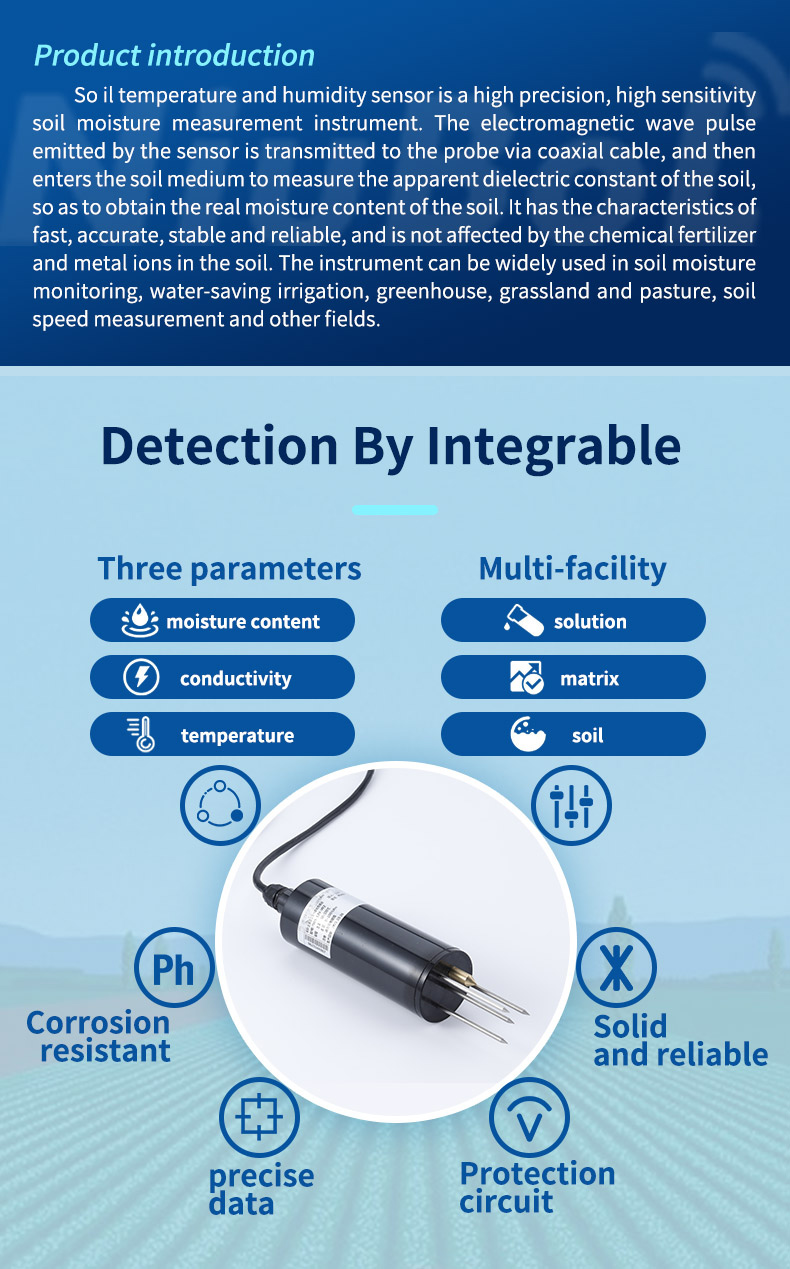

— Blogs —
—Products—
 Consumer hotline +8618073152920
Consumer hotline +8618073152920 WhatsApp:+8615367865107
Address:Room 102, District D, Houhu Industrial Park, Yuelu District, Changsha City, Hunan Province, China
Product knowledge
Time:2022-05-10 21:38:27 Popularity:754
Analysis and Comparison of Three Soil Moisture Sensors
Through the research on three kinds of soil moisture sensors, it can be seen that the capacitive soil moisture sensor is composed of interdigitated aluminum strips to form the electrodes of the capacitor, and uses air as the dielectric of the capacitor. The capacitance value will also change, so the capacitor can be used as a soil moisture sensor;
The resistance type soil moisture sensor is composed of many small units formed by two electrodes passing through the moisture sensing layer. The resistance value changes by changing the number of small units, so it can be used as a soil moisture sensor;
The ion-sensitive soil moisture sensor consists of a sensitive membrane and a converter. The sensitive membrane is used to identify the type and concentration of ions, and the converter converts the information sensed by the sensitive membrane into electrical signals, so it can also be used as a soil moisture sensor.

At the same time, according to the structural schematic diagrams of three different types of soil moisture sensors, it is found that due to the incompatibility of porous silicon with CMOS technology, the process conditions and post-processing of porous silicon preparation, and the control of pore size and pore size are difficult.
The wet mechanism is more complicated, so the main moisture sensing medium of CMOS humidity sensor is mainly polyphthalimide. Polyphthalimide-based sensors are compatible with CMOS processes, cost less, do not require high-temperature processing and thermal cleaning, and are not as susceptible to humidity as porous ceramics. However, if the resistive humidity sensor and the ion-sensitive humidity sensor are produced by the CMOS process, they need to change more CMOS processes.

For example: changing the sequence of production processes, using new masks, etc., will cost a lot of tape-out funds; and compared with standard CMOS processes, the process is less mature, increasing the risk of tape-out; at the same time, they There are difficulties in packaging with peripheral electronics.
In addition, the capacitive humidity sensor (CHS) has received extensive attention due to its large sensing relative humidity range, simpler structure and equivalent form, and easier production process. The advantage of using polyphthalimide with comb-shaped aluminum electrode structure as the moisture-sensing medium of capacitive soil moisture sensor is that it is compatible with CMOS process, can be processed by mature standard CMOS process, and the processing technology is relatively simple, so it can be Integrate more devices (sensitive devices or peripheral circuit devices) on the same chip or package them together, so that the soil moisture sensor has better performance or more functions. At the same time, it is conducive to the development of the soil moisture sensor in the direction of miniaturization, integration, low cost, and comprehensive functions.
Related recommendations
Sensors & Weather Stations Catalog
Agriculture Sensors and Weather Stations Catalog-NiuBoL.pdf
Weather Stations Catalog-NiuBoL.pdf
Related products
 Combined air temperature and relative humidity sensor
Combined air temperature and relative humidity sensor Soil Moisture Temperature sensor for irrigation
Soil Moisture Temperature sensor for irrigation Soil pH sensor RS485 soil Testing instrument soil ph meter for agriculture
Soil pH sensor RS485 soil Testing instrument soil ph meter for agriculture Wind Speed sensor Output Modbus/RS485/Analog/0-5V/4-20mA
Wind Speed sensor Output Modbus/RS485/Analog/0-5V/4-20mA Tipping bucket rain gauge for weather monitoring auto rainfall sensor RS485/Outdoor/stainless steel
Tipping bucket rain gauge for weather monitoring auto rainfall sensor RS485/Outdoor/stainless steel Pyranometer Solar Radiation Sensor 4-20mA/RS485
Pyranometer Solar Radiation Sensor 4-20mA/RS485
Screenshot, WhatsApp to identify the QR code
WhatsApp number:+8615367865107
(Click on WhatsApp to copy and add friends)